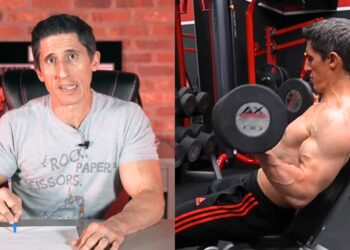Big, defined biceps are the epitome of show muscles because they’re very visually pleasing when nicely developed and they’re the first pair of muscle visible when wearing a short sleeve shirt. But great biceps don’t come that easily which is why they’re not all that common. So utilizing the right bicep exercises will assure max growth and development.
But we’ll be honest with you…It takes hard work in the gym, lots of high-quality food, and even good genetics to build awesome biceps.
However…
Anyone can build head-turning biceps regardless of their genetics, with the right tools and strategic game plan.
Now, you should be training with maximum variety and intensity in your bicep workouts but diet is also an important factor when looking to increase the size of any muscle… period! So, make sure you’re getting in enough protein with equally sufficient carbs and fats from whole foods, and supplements. (1)
But for now… we’re just focusing on the training aspect, and we’d like to share with you 4 unconventional exercises which are different from the typical (And sometimes boring) barbell, and dumbbell curl routines you see in every gym…
Level Up Your Fitness: Join our 💪 strong community in Fitness Volt Newsletter. Get daily inspiration, expert-backed workouts, nutrition tips, the latest in strength sports, and the support you need to reach your goals. Subscribe for free!

Bonus: Two of these exercises really target the forearms for even more growth, function, and aesthetics!
1-Cable Overhead Curls on Lat Pulldown Machine
You won’t see too many people doing this variation at the gym but it is a fantastic bicep exercise to add into your workout. The cable overhead curl is an unconventional exercise which allows you to feel a contraction like no other since your arms are positioned above your head.
This forces your biceps in an almost fully isolated position and the use of momentum is limited. The great thing about using cables is that they always keep tension on the muscle regardless of your position.
But, what’s so great about this exercise?
- Cables keep constant tension on the muscle, which is necessary for growth stimulus.
- You can get a better bicep contraction because of the overhead angle which really isolates the muscle. Since your arms are positioned overhead, you cannot use as much momentum or other muscles to assist in the lift like with standing or sitting curls.
How to perform the exercise:
- Begin by adjusting the leg support pads to secure your body during the exercise.
- Then stand up, grab the bar with a supinated grip about shoulder-width apart and sit back down with legs secured.
- Keep your back straight and upright.
- Now, with your arms extended, slowly curl the bar behind your head while leaning slightly forward, and contract your biceps for a couple of seconds.
- Then slowly allow the bar to return to the starting position with arms extended upward but don’t lock out at the top.
- Repeat for the desired number of reps.
Tip: Try to avoid rocking and using momentum to get the best biceps contraction possible.
Sets/Reps: Perform 3-4 sets of 10-12 reps
2-Partial Mid-Range Bicep curls
So, you probably hear this statement all the time… “You must use a full range of motion”… blah blah blah. You see, the reason why many people never get results is that they follow what everyone else is doing and they believe what everyone else is saying.
Well, we hate to break it to you but not everything you hear is true, and many people get better results from using a shorter range of motion during their bicep workouts, and any workout for that matter…
In fact, a study showed partial reps to be very beneficial for increasing strength when tested on untrained men for 10 weeks. (2)
And we know that… more strength = more gains!
Another study showed partial reps to be effective for muscle thickness as well. But it’s important to remember that the range of motion varies for everyone since we are all built differently. So, there’s no one right way to train for every situation. (3)
Benefits of partial reps:
- You can use more weight
- You can better prevent injuries
- You keep constant tension on the muscle
- You can perform more reps
Now, this doesn’t mean you should never use a full range of motion, but there’s a time and a place for this… but if you’re still not convinced of the benefits of partial reps for muscle mass and strength, then we feel sorry for the gains you’ll be leaving on the table.
But no, seriously… partial mid-range reps are game-changer and you’ll find yourself progressing rather quickly.
How to perform a partial mid-range bicep curl:
- Pick up a barbell or a dumbbell in each hand and hold them at your sides with legs in a shoulder-width stance.
- Keep your back straight and bend your knees slightly.
- Curl the weight halfway up and begin performing the repetitions in the middle range of the movement.
Tip: Choose a weight where you don’t have to use too much momentum because then you defeat the purpose of the partial rep.
Sets/Reps: Perform 3-4 sets of 8-10 reps
3-Close-Grip Pronated Pull-Ups
You may have never seen anyone do this exercise but its excellence for bicep, forearm, and grip development is unmatched.
Now, it’s important to mention that the close-grip pronated pull-up with body weight only is not for everyone, as you do need a decent amount of strength to do it effectively. However, a pull-up assist machine now makes this effective bicep exercise possible for anyone.
Level Up Your Fitness: Join our 💪 strong community in Fitness Volt Newsletter. Get daily inspiration, expert-backed workouts, nutrition tips, the latest in strength sports, and the support you need to reach your goals. Subscribe for free!
The close hand position and pronated grip really target the brachialis and brachioradialis muscles (Along with the biceps) since you’re using these muscles to do a lot of the pulling.
The brachialis muscle is the prime mover for elbow flexion and it sits just behind and to the side of the bicep muscle. When fully developed it adds width and extra size to the arms. (4)
The brachioradialis muscle is highly responsible for elbow flexion in the pronated position and it runs along the top of the forearm up to the bicep insertion. Now, according to studies, the brachioradialis has an advantage over the biceps in a pronated position, and muscular activity is higher than a supinated or neutral position. (5, 6)
How to perform the exercise:
- Grab the pull-up bar with a pronated grip an inch apart from each other on the bar.
- Pull yourself as high as you can.
- Slowly allow yourself to come back down to the starting position with arms extended.
- Repeat
Tip: You can use slight momentum by slightly swinging your knees upward during the pull-up.
Sets/Reps: Perform 3 sets of AMRAP (As many reps as possible).
4- Standing Dumbbell Incline Hammer Curls
There’s a lot of focus on supinated curls with most bicep workouts but using a neutral/hammer grip can take your gains to the next level…
The hammer grip really hits the brachialis and brachioradialis muscles to push extra growth out of your biceps and forearms, so you can really turn heads while wearing a tight short-sleeve shirt!
How to perform the exercise:
- Set up a bench so that it’s at a high inclined angle.
- Grab a dumbbell with a neutral-grip and lay your arm on the bench with your armpit covering the top part of the bench. One side of the dumbbell should be resting on the bench.
- Slowly curl the dumbbell to the top and squeeze for a couple of seconds.
- Then, slowly lower the dumbbell to the starting position so one side of the dumbbell touches the bench.
- Repeat
Tip: Choose a lighter dumbbell so you do not have to use any momentum. This keeps all the tension on the working muscle.
Sets/Reps: Perform 3-4 sets of 10-12 reps
Sample Bicep Workout Routine:
Here’s a sample bicep routine you can use which includes the bicep exercises listed above. Note: If you train your biceps twice per week, perform 3 sets of two exercises per workout to avoid overtraining.
Otherwise, you can use this sample routine if you train biceps once per week. The biceps are a small muscle group so you only want to stimulate them… not annihilate them!
Cable Overhead Curls on Lat Pull-Down Machine – 3 sets x 10-12 reps
Mid-Rep Partial Curls – 3 sets x 8-10 reps
Close-Grip Pronated Pull-Up – 2 sets x AMRAP (As many reps as possible)
Standing Dumbbell Incline Hammer Curls – 3 sets x 10 reps
Final Thoughts
Prioritizing biceps training will go a long way for your complete arm development potential. But the right bicep exercises, training intensity, and of course nutrition will determine the ultimate size of your bicep muscles.
Now, it’s important to know that there’s not just one best workout for biceps but using variety in your training is key to building big guns!
So… for best results, include these amazing unconventional exercises in combination with your barbell and dumbbell curls for maximum growth!
But remember, the biceps are a smaller muscle compared to most other muscle groups so you only need to do a few exercises to stimulate them effectively.
References
- “Building Muscle Simplified: Not as Complicated as you Think: ISSA Online.edu”. www.issaonline.edu. Retrieved 2019-03-31.
- Massey, C. Dwayne; Vincent, John; Maneval, Mark; Moore, Melissa; Johnson, J. T. (2004-8). “An analysis of full range of motion vs. partial range of motion training in the development of strength in untrained men”. Journal of Strength and Conditioning Research. 18 (3): 518–521. doi:10.1519/13263.1. ISSN 1064-8011. PMID 15320644.
- Pinto, Ronei S.; Gomes, Naiara; Radaelli, Régis; Botton, Cíntia E.; Brown, Lee E.; Bottaro, Martim (2012-8). “Effect of range of motion on muscle strength and thickness”. Journal of Strength and Conditioning Research. 26 (8): 2140–2145. doi:10.1519/JSC.0b013e31823a3b15. ISSN 1533-4287. PMID 22027847.
- Leonello, Domenic T.; Galley, Ian J.; Bain, Gregory I.; Carter, Christopher D. (2007-6). “Brachialis muscle anatomy. A study in cadavers”. The Journal of Bone and Joint Surgery. American Volume. 89 (6): 1293–1297. doi:10.2106/JBJS.F.00343. ISSN 0021-9355. PMID 17545433.
- Kleiber, Tim; Kunz, Leo; Disselhorst-Klug, Catherine (2015-08-06). “Muscular coordination of biceps brachii and brachioradialis in elbow flexion with respect to hand position”. Frontiers in Physiology. 6. doi:10.3389/fphys.2015.00215. ISSN 1664-042X. PMC PMCPMC4526813. PMID 26300781.
- “Brachioradialis”. www.meddean.luc.edu. Retrieved 2019-03-31.
Also check out other Bicep Workouts:









Post pictures for a visual reference.